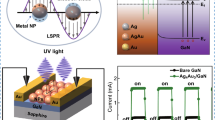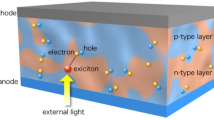Abstract
The surface plasmonic effect and scattering effect of gold nanorods (AuNRs) on the performance of bulk heterojunction photovoltaic devices based on the blend of polythiophene and fullerene are investigated. AuNRs enhance the excitation since the plasmonic effect increases the electric field, mainly in the area near the interface between the active layer and AuNRs. The results show that the incident photo-to-electron conversion efficiency (IPCE) obviously increases for the device with a layer of gold nanorods, resulting from the plasmonic effect of AuNRs in the range of 500–670 nm and the scattering effect in the range of 370–410 nm. The power conversion efficiency (PCE) is increased by 7.6% due to the near field effect of the localized surface plasmons (LSP) of AuNRs and the scattering effect. The short circuit current density is also increased by 9.1% owing to the introduction of AuNRs. However, AuNRs can cause a little deterioration in open circuit voltage.
Similar content being viewed by others
References
Krebs F C, Jørgensen M, Norrman K, et al. A complete process for production of flexible large area polymer solar cells entirely using screen printing-first public demonstration. Sol Energy Mater Sol Cells, 2009, 93: 422–441
Liu Y, Shen H, Deng Y J. A novel solar cell fabricated with spiral photo-electrode for capturing sunlight 3-dimensionally. Sci China Tech Sci, 2006, 49(6): 663–673
You J B, Dou L T, Yoshimura K, et al. A polymer tandem solar cell with 10.6% power conversion efficiency. Nat Comm, 2013, 4: 1446–1455.
Pillai S, Green M A. Plasmonics for photovoltaic applications. Sol Energ Mat Sol C, 2010, 94: 1481–1486
Dionne J A, Sweatlock L A, Atwater H A. Planar metal plasmon waveguides: frequency-dependent dispersion, propagation, localization, and loss beyond the free electron model. Phys Rev B, 2005, 72: 075405–075415.
Catchpole K R, Polman A. Design principles for particle plasmon enhanced solar cells. Appl Phys Lett, 2008, 93: 191113–191115
Stuart H R, Hall D G. Absorption enhancement in silicon-on-insulator waveguides using metal island films. Appl Phys Lett, 1996, 69: 2327–2319
Beck F J, Polman A, Catchpole K R. Tunable light trapping for solar cells using localized surface plasmon. J Appl Phys, 2009, 105(11): 114310–114317
Yang J, You J B, Chen C C, et al. Plasmonic polymer tandem solar cell. ACS Nano, 2011, 5: 6210–6217
Stavytska B M, Salvador M, Kulkarni A, et al. Plasmonic enhancement of Raman scattering from the organic solar cell material P3HT/PCBM by triangular silver nanoprisms. J Phys Chem C, 2011, 115: 20788–20794
Qiao L F, Wang D, Zuo L J, et al. Localized surface plasmon resonance enhanced organic soalr cell with gold nanospheres. Appl Energ, 2011, 88: 848–852.
Heo M, Cho H, Jung J W, et al. High-performance organic optoelectronic devices enhanced by surface plasmon resonance. Adv Mater, 2011, 23: 5689–5693
Wang D H, Park K H, Seo J H, et al. Enhanced power conversion efficiency in PCDTBT/PC70BM bulk heterojunction photovoltaic devices with embedded silver nanoparticle clusters. Adv Energ Mater, 2011, 5: 766–770
Xie F X, Choy C H W, Wang C D C, et al. Improving the efficiency of polymer solar cells by incorporating gold nanoparticles into all polymer layers. Appl Phys Lett, 2011, 99: 153304–153306
Wu J L, Chen F C, Hsiao Y S, et al. Surface plasmonic effects of metallic nanoparticles on the performance of polymer bulk heterojunction solar cells. ACS Nano, 2011, 5(2): 959–967
Wang D H, Kim D Y, Choi K W, et al. Enhancement of donor-acceptor polymer bulk heterojunction solar cell power conversion efficiencies by addition of Au nanoparticles. Angew Chem Int Ed, 2011, 50: 5519–5523
Yoon W J, Jung K Y, Liu J W, et al. Plasmon enhanced optical absorption and photocurrent in organic bulk heterojunction photovoltaic devices using self-assembled layer of silver nanoparticles. Sol Energ Mater Sol C, 2010, 94: 128–132
Gao H L, Zhang X W, Yin Z G, et al. Plasmon enhanced polymer solar cells by spin-coating Au nanoparticles on indium-tin-oxide substrate. Appl Phys Lett, 2012, 101: 133903–133906
Jain P K, Eustis S, El-Sayed M A. Plasmon coupling in nanorod assemblies: optical absorption, discrete dipole approximation simulation, and exciton-coupling model. J Phys Chem B, 2006, 110: 18243–18253
Catchpole K R, Polman A. Design principles for particle plasmon enhanced solar cells. Appl Phys Lett, 2008, 93: 191113–191115
Mahmouda A Y, Zhang J M, Mac D L, et al. Optically-enhanced performance of polymer solar cells with low concentration of gold nanorods in the anodic buffer layer. Org Electron, 2012, 13: 3102–3107.
Seo S S, Wang X H, Murray D. Direct monitoring of gold nanorod growth. Ionics, 2009, 15: 67–71
Perez-Juste J, Pastoriza-Santos I, Liz-Marzan L M, et al. Gold nanorods: Synthesis, characterization and applications. Coordin Chem Rev, 2005, 249: 1870–1901
Cortie M B. The weird world of nanoscale gold. Gold Bull, 2005, 37: 1–2
Pissuwan D, Valenzuela S, Cortie M B. Therapeutic possibilities of plasmonically heated gold nanoparticles. Trends Biotechnol, 2006, 24(2): 62–67
Palik E D. Handbook of Optical Constants of Solids. New York: Academic Press, 1997
Biring S, Wang H H, Wang J K. Light scattering from 2D arrays of monodispered Ag-nanoparticles separated by tunable nano-gaps: spectral evolution and analytical analysis of plasmonic coupling. Opt Express, 2008, 16(20): 15312–15324
Lee J H, Cho S, Roy A. Enhanced diode characteristics of organic solar cells using titanium suboxide electron transport layer. Appl Phys Lett, 2010, 96: 163303–163305
Schilinsky P, Waldauf C, Brabec C J. Performance analysis of printed bulk heterojunction solar cells. Adv Funct Mater, 2006, 16: 1669–1672
Lee J H, Park J H, Kim J S. High efficiency polymer solar cells with wet deposited plasmonic gold nanodots. Org Electron, 2009, 10: 416–420
Lakowicz J R. Radiative decay engineering 5: metal-enhanced fluorescence and plasmon emission. Anal Biochem, 205, 337: 171–194
Murray W A, Barnes W L. Plasmonic materials. Adv Mater, 2007, 19: 3771–3782
Bellessa J, Bonnand C, Plenet J C. Strong coupling between surface plasmons and excitons in an organic semiconductor. Phys Rev Lett, 2004, 93: 036404–036407
Lee J, Hernandez P, Lee J. Exciton-plasmon interactions in molecular spring assemblies of nanowires and wavelength-based protein detection. Nat Mater, 2007, 6: 291–295
Ru L E C, Etchegoin P G, Grand J. Mechanisms of spectral profile modification in surface-enhanced fluorescence. J Phys Chem C, 2007, 111: 16076–16079
Ohkita H, Cook S, Astuti Y. Bimolecular recombination losses in polythiophene: Fullerene solar cells. J Am Chem Soc, 2008, 130: 3030–3033
Author information
Authors and Affiliations
Corresponding author
Rights and permissions
About this article
Cite this article
Fang, Y., Hou, Y., Lou, Z. et al. Surface plasmonic effect and scattering effect of Au nanorods on the performance of polymer bulk heterojunction solar cells. Sci. China Technol. Sci. 56, 1865–1869 (2013). https://doi.org/10.1007/s11431-013-5263-9
Received:
Accepted:
Published:
Issue Date:
DOI: https://doi.org/10.1007/s11431-013-5263-9




